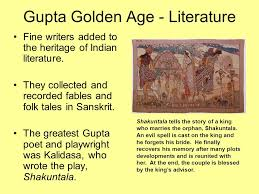SamudraGupta, who was nominted successor to the imperial throne of the Guptas, after A.D 320 and died before A.D 380. He appears to be mentioned in the “Arya manju sri mula kalpa” and also in the Tantrikamandala, Javanese text.
The Gupta period is known
as the “Golden age” owing to its rich contribution to literature and
science. The Sanskrit literature under the Gupta period reached extraordinary
heights, and the era witnessed the greatest writers and poets of all time. The
Gupta period is distinct from the rest of ancient Indian history.
The Sanskrit language,
once ignored under the Buddhist and Jain influence, was patronised during the
Gupta period. It was recognised as the court language and was used in their
inscriptions. Gradually it became the lingua franca of India. Even Buddhist
scholars, especially the followers of the Mahayana cult, began writing their
scriptures in Sanskrit. The Jain writers too, who had been writing in Pali and
Prakrit, switched over to Sanskrit, which gradually became the literary
language of northern India.
The Gupta rulers encouraged
higher learning by patronizing centers of higher education at Nalanda,
Takshila, Ujjain, Vikramshila and Vallabhi. Each university specialized in
a particular field of study. Takshila specialized in the study of medicine,
while Ujjain laid emphasis on astronomy. Nalanda, being the biggest centre,
handled all branches of knowledge. During the Gupta period India became a
centre for higher studies by attracting scholars from all parts of India and
from several foreign countries.
Nalanda
University. Nalanda, situated near Rajgriha in Bihar, was probably the highest
seat of Buddhist learning. It was established as a Buddhist monastery probably
during the reign of Kumara Gupta I (414-445 A.D). A Buddhist tradition says
that Sakraditya established this centre of learning. It was spread over an area
of 1:6 km x 0.8 km. It had about 1500 professors and 10,000 students. Such
eminent people as Panini, Jivaka and Chanakya are said to have studied there. The
university had helped to spread Indian culture in foreign countries such as
Tibet, China, and Central Asia and also in South East Asian countries.
Takshila
University. This centre of learning was situated about 50 km west of
Rawalpindi in Pakistan. It was not a well-organized university like Nalanda.
Panini, the famous Sanskrit grammarian, Kautilya who wrote Arthashastra and
Charaka, the famous physician of ancient India, and Chandragupta Maurya were
the products of this university.
Great poets, dramatists,
grammarians and playwrights lived in the period. Some of the well-known
scholars who flourished during this period are mentioned below:
Kalidasa was the greatest Sanskrit poet and playwright of this age. Meghadutam
and Rtu Samharam are his lyrical poems, while Kumara Sambhavam
and Raghuvamsam are great epic poems. Among his plays, Abhijnana
Shakuntalam is known for its fine characters, imagery and choice of words.
Among his other plays the most important are Vikramorvasiyam and Malvikagnimitram.
Visakhadatta was a great poet and playwright of the Gupta period.
His two great historical plays are Mudra-Rakshasam and Devi Chandra
Guptam. Mudra-Rakshasam (seal of Rakshasa) was the story of how
Chandragupta Maurya managed to get the throne of Magadha. Devi Chandra Guptam
is a historical play dealing with the early life of Chandragupta II.
Sudraka wrote the famous play Mrichchakatikam which throws
light on the socio-cultural conditions of the Gupta period.
Harisena was court poet of Samudragupta. He wrote a famous poem
praising the valour of Samudraguta. The poem is inscribed on the Allahabad
Pillar.
Bharavi wrote the great epic Kiratarjuniyam. In this epic he
describes the battle between Arjuna and Lord Shiva disguised as 'Kirata'.
Dandin was a versatile writer. His Dasa Kumara Charitam
(Tales of the Ten Princes) describes the adventures of ten princes. These
adventures give us information on the socio-cultural conditions of that period.
Subandhu was a prose writer. In his famous Vasavadatta, he
narrates the story of the heroine Vasavadatta and prince Kandarpaketu. During
the Gupta period the Sanskrit grammar was systematically written by such
grammarians as Panini and Patanjali.
During the Gupta period the Panchatantram, a collection of fables, was
written by the great scholar VishnuSarma. It is said that these stories
were written to teach statecraft to disinterested princes. In these stories,
animals and birds play the part of king's ministers and common men. These
animal stories were a help in instructing children in moral values. The famous
work Hitopadesa of NarayanaKavi is based on Panchatantra. The
Panchatantra has been translated into many languages and no other book except
the Bible has been translated into so many languages as this famous book. The
book is a treasure-house of people's feelings and emotions in human relations.
The stories contain wisdom and common sense needed for daily living.
Sanskrit was the Guptas' court language, and while the period produced considerable Brahmanical sacred writing, it also generated a few of the earliest secular works. To conclude, the era witnessed the flourishing of Sanskrit literature under the Gupta period.






No comments:
Post a Comment